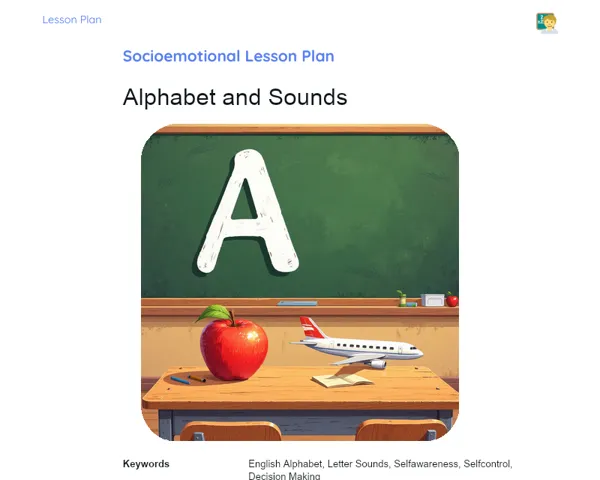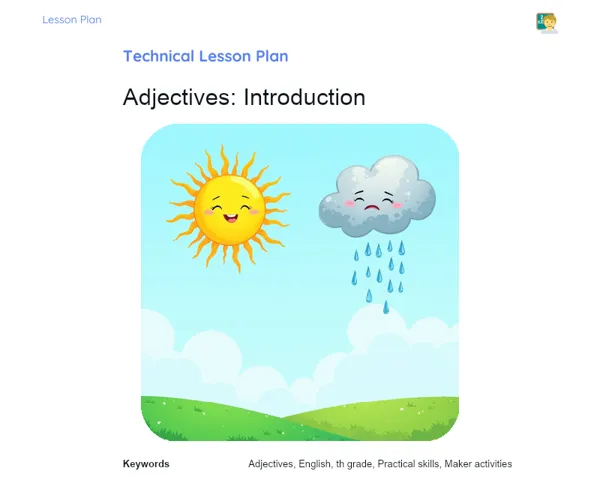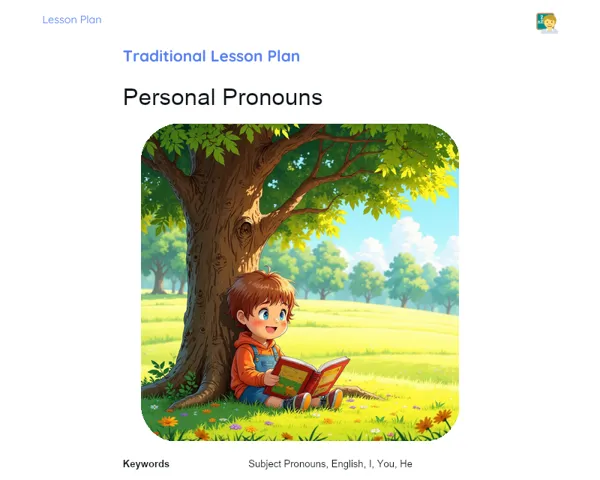Lesson Plan | Lesson Plan Tradisional | Possessive Pronouns
| Keywords | Possessive Pronouns, Identification, Correct Use, Possessive Adjectives, Practical Examples, Sentences, Student Engagement, Review, Consolidation |
| Resources | Whiteboard and markers, Projector or slides with visual examples, Exercise sheets, Pens and pencils, Notebooks, Classroom objects for practical examples (books, pens, etc.) |
Objectives
Duration: 10 - 15 minutes
This lesson plan aims to help learners grasp what is expected regarding possessive pronouns. It includes not just recognizing the pronouns, but also their use in sentences to express ownership. Clear objectives guide both teaching and learning, giving direction for the lesson.
Objectives Utama:
1. Identify and list the main possessive pronouns in English.
2. Understand how possessive pronouns express ownership in sentences.
3. Use possessive pronouns in practical examples to demonstrate understanding.
Introduction
Duration: 10 - 15 minutes
The aim of this section is to grab learners' attention and situate the topic of possessive pronouns in everyday contexts, highlighting their relevance. By linking lesson content to real-life situations, learners will be more engaged and keen to learn. Providing context prepares their minds for the new information to come.
Did you know?
We use possessive pronouns all the time, from casual chats to formal documents. For example, saying 'This is my friend' or 'That is her house' showcases possessive pronouns indicating ownership. In business, they play a vital role in emails and contracts to specify ownership rights or properties.
Contextualization
Kick off the lesson by introducing the concept of ownership and belonging. Explain to learners how possessive pronouns are used in Portuguese to show that something belongs to someone, using terms like 'meu', 'seu', 'nosso'. Then, transition to English, highlighting that similar to Portuguese, possessive pronouns indicate ownership but come in different forms: 'my', 'your', 'his', 'her', 'its', 'our', 'their'. Use visuals and objects from the classroom to illustrate: 'This is my book', 'That is your pen'.
Concepts
Duration: 45 - 50 minutes
The aim here is to deepen learners' understanding of possessive pronouns, ensuring they grasp their definition, correct use, and distinctions from possessive adjectives. This stage provides guided practice, allowing learners to apply their newfound knowledge in exercises that reinforce their learning.
Relevant Topics
1. Definition of Possessive Pronouns: Explain that possessive pronouns indicate ownership. Provide examples like 'my', 'your', 'his', 'her', 'its', 'our', 'their'.
2. Correct Use of Possessive Pronouns: Illustrate how each possessive pronoun is used in sentences. For instance, 'This is my book' and 'That is her pen'.
3. Difference between Possessive Pronouns and Possessive Adjectives: Clarify how possessive pronouns (mine, yours, his, hers, ours, theirs) differ from possessive adjectives (my, your, his, her, its, our, their). Use sentences to demonstrate their usage.
To Reinforce Learning
1. Fill in the blank with the correct possessive pronoun: 'This book belongs to John. It is ____.'
2. Replace the underlined expression with the correct possessive pronoun: 'The house of Maria is big.'
3. Choose the correct form of the possessive pronoun to finish the sentence: 'This is not my pen, it's ____. (your/yours)'
Feedback
Duration: 25 - 30 minutes
This stage aims to recap and solidify learners' understanding of possessive pronouns and their proper use. By discussing the answers in depth, we can clear up any confusion and reinforce learning. Additionally, engaging learners with reflective questions fosters a deeper and more critical understanding of the content.
Diskusi Concepts
1. Discussion of the questions presented in the Development stage: 2. 1. Fill in the blank with the correct possessive pronoun: 'This book belongs to John. It is ____.' 3. - Answer: 'It is his.' 4. - Explanation: The possessive pronoun 'his' indicates something belonging to a male. Thus, the book belongs to John, making 'his' the right choice. 5. 2. Replace the underlined expression with the correct possessive pronoun: 'The house of Maria is big.' 6. - Answer: 'Her house is big.' 7. - Explanation: 'Her' is the possessive adjective indicating ownership by a female. Here, we replace 'The house of Maria' with 'Her house'. 8. 3. Choose the correct form of the possessive pronoun to complete the sentence: 'This is not my pen, it's ____. (your/yours)' 9. - Answer: 'It's yours.' 10. - Explanation: 'Yours' is the correct possessive pronoun to substitute 'your pen' in this context.
Engaging Students
1. Questions and Reflections to Engage Learners: 2. 1. Why is correct use of possessive pronouns important in a sentence? 3. 2. How do possessive pronouns in English differ from those in Portuguese? 4. 3. Can you create a sentence using the possessive pronoun 'theirs'? 5. 4. How would you determine the correct possessive pronoun without knowing who the object belongs to? 6. 5. What did you find most challenging about learning possessive pronouns? How can we simplify it?
Conclusion
Duration: 10 - 15 minutes
This section is meant to summarise and reinforce what learners have learned, ensuring all key points are understood. Reviewing content and emphasizing its real-world relevance boosts retention and prepares learners for using possessive pronouns confidently in their daily interactions.
Summary
['Definition of possessive pronouns in English.', "List of main possessive pronouns: 'my', 'your', 'his', 'her', 'its', 'our', 'their'.", 'Proper use of possessive pronouns in sentences.', 'Difference between possessive pronouns (mine, yours, his, hers, ours, theirs) and possessive adjectives (my, your, his, her, its, our, their).', 'Practical examples and exercises using possessive pronouns.']
Connection
The lesson tied together the theory of possessive pronouns with practical application through visual examples and guided exercises. Learners got to see how pronouns function in real-life contexts and applied that knowledge through hands-on activities, which greatly enhanced their learning.
Theme Relevance
Possessive pronouns are vital in our day-to-day interactions, enabling us to communicate clearly about ownership of objects, ideas, or feelings. Whether in informal chats or professional settings, using these pronouns correctly helps us avoid misunderstandings and enhances effective communication.



